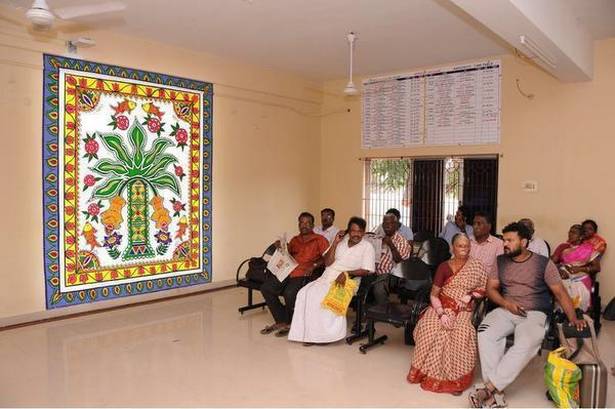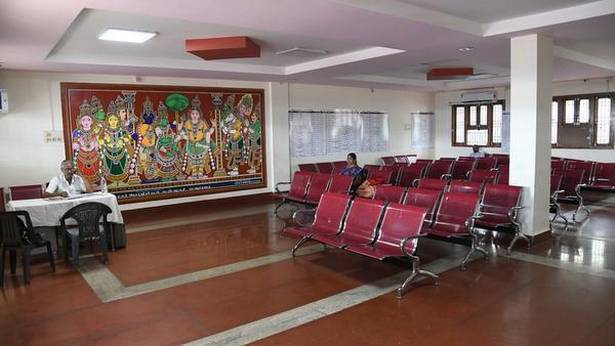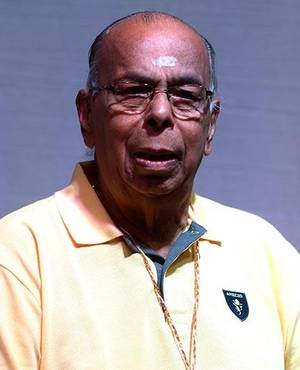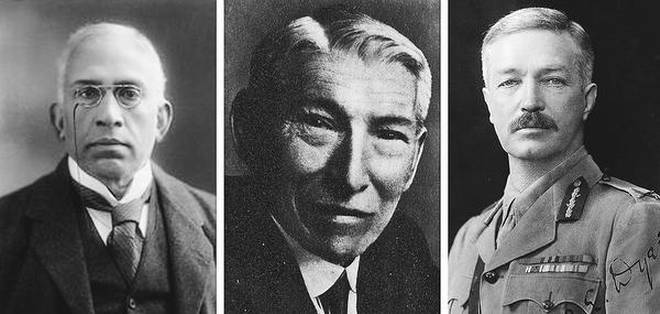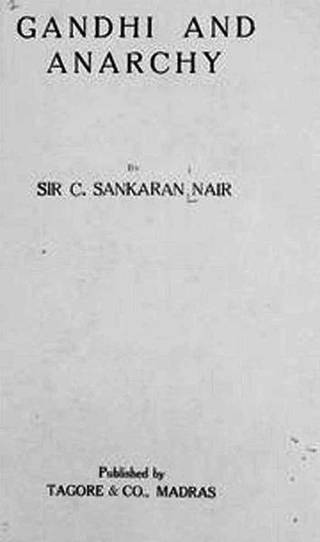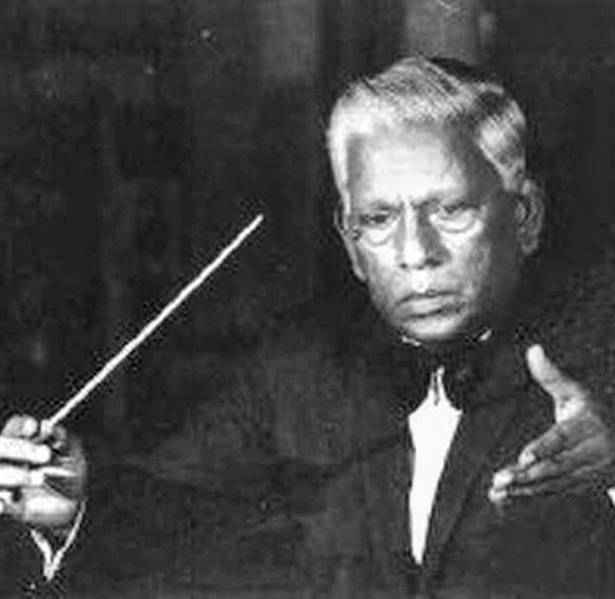Adding colour to train journeys
The Madurai railway junction has been adjudged the second most beautiful station in the country and behind the laurel is the efforts of two local artists
The side-wall of the escalator on the second platform inside Madurai railway junction, presents a picturesque and colourful painting. The imposing wall of 60 feet by 23 feet depicts a scene from rural Tamil Nadu, replete with bucolic paddy fields, farmers, huts, rolling mountains and lush greenery. The painted wall has become an attraction for passengers who pause to take a look at the grand and elaborate piece of art. Similarly, a two-dimensional mural measuring 14feet by seven feet adorns the wall inside the AC waiting hall on the station’s first platform. The mural painted in the Tanjore style of painting showcases the event of Meenakshi Tirukalyanam and has added a tinge of colour to the hall.
In a bid to beautify one of the biggest railway junctions in the region, the management roped in arists A Kannan and G K Ramesh to do up some art in strategic places inside the station. “It’s part of the ongoing project by Ministry of Railways. The idea is to showcase local talent in beautifying the place.” says Neenu Ittyerah, Divisional Railway Manager, Madurai Division. In a contest held recently in which 68 stations took part, the Madurai junction has won the award of second most beautiful railway station in the country, along with Madhubani station of East Central Railways. The first prize is won by Chandrapur and Ballarshah stations of Maharashtra. “It took quite an effort to decide on what and how to paint. We wanted to have some variety so we decided to paint two different things in different styles. Station art is evolving as a genre in itself and has to be big, bold and visible. Hence, we chose the escalator wall and the waiting hall. While the first one was based on a generic theme and made in a modern poster-art style, the second one was traditional Tanjore painting choosing a theme that’s typical of Madurai and what better than Meenakshi Kalyanam, as the event is celebrated by the entire town.”
A Kannan, who works as art teacher in TVS Matriculation School, Palanganatham and his team of assistants worked for over 10 days to complete the painting on the escalator wall. “I have used enamel paint and a combination of soothing cool colours. Since the base colour of the corrugated tin wall was blue, I retained a blue background. We had to build a scaffolding to reach to the height and chalk out a graph, so that the painting can be done to scale,” says Kannan, who has contributed in the Madurai corporation’s beautification projects previously. He has painted the pillars beneath the Kalpalam bridge and the wall around Gandhi Museum. “That’s how I got the opportunity to paint the station as well. I enjoyed the process and I am happy that my work has earned the place the distinction.”
The mural art is done by GK Ramesh, Stapati belonging to Sirkazhi. Having painted some of the famous and big temples across the state, Ramesh is an expert in Temple Art. “I come from a family of temple artists and learnt it from my father. In 2009, I repainted the frescos on the ceilings and walls of Meenakshi Temple. That’s how I was recommended for drawing a mural at the station,” says Ramesh. “I have used acrylic paint and my style is inspired by Indian art before the period of Ravi Varma, characterised by flat two-dimensional figures,” says Ramesh. “Though I have showcased my skills in temples like Tiruparankundram, Pazhamudhircholai and Srivilliputtur, drawing at the railway station gave me a unique experience. I am grateful and glad that my art has bagged a national-level recognition.”
The other stations under Madurai Division that were beautified are Virudhunagar and Kovilpatti, where the side of a staircase and a wall have been painted respectively. “We nailed the brief and that’s one reason we got the prize. From the railways, we will continue to add art and value to stations. The next stations we will be working on are Rameshwaram and Kodai Road/Dindigul, as they attract heavy flow of tourists. In Kovilpatti, one of our staff has done a worli art and we encourage such initiatives,” says Ittyerah. “Railway stations need to look good for two reasons – one is that it’s a highly patronised public space and creating beauty outside home will instil a sense of ownership in people using the space. And secondly, railway junctions are places that leave an impression in the mind of every traveller. You also always take something from a station.”
Madurai Division
Madurai Division was formed on 16.05.1956 and it is the largest Division on Southern Railway with 1363.06 Route Kilometers, extending over 12 districts of Tamilnadu, viz., Madurai, Virudhunagar, Tirunelveli, Tuticorin, Dindigul, Theni, Sivagangai, Ramanathapuram, Pudukottai, Tiruppur, Coimbatore and Tiruchchirappalli and 1 district of Kerala, viz., Kollam.
The total BG line is 1298.80 km and 118.12 km is under gauge conversion ie.89.74 kms between Madurai and Bodinayakkanur.
The division has 99 block stations, 20 flag stations and 20 halt stations. The division is running 39 pairs of daily express trains and 45 pairs of non-daily express trains and 70 pairs of daily passenger trains and 4 pairs of non-daily passenger trains.
Madurai Junction
Madurai Jn. is a ‘A-1’ category station with an average earnings of Rs.37 lakhs per day and an average of 44 lakhs passengers are dealt per day. The station has six platforms, six UTS and eight PRS counters.
Number of trains dealt:
Express trains: 12 pairs of daily, five pairs of bi-weekly, three pairs of tri-weekly, one pair of quadruplet weekly and six pairs of weekly
Passenger trains: 13 pairs of daily
Bookings office, Food plaza, Catering stall, Retiring rooms, Water cooler, Automatic Water Vending machines, RO water plant, Waiting halls, Mother feeding centre, Escalators, Lifts, Wheel chairs and Pay and use toilets are the other facilities provided at the junction.
source: http://www.thehindu.com / The Hindu / Home> Society / by A. Shrikumar / May 11th, 2018
Comedian Neelu is no more
Known for his booming voice, he had made a mark both in films and stage plays
Comedian Neelu, remembered for his characteristic entry onto the stage and the screen, always humming a snatch from some Carnatic song, died here on Thursday after a prolonged hospitalisation. He was 82 and is survived by wife and two sons.
“The only time he did not make his typical entry was when he played the role of Yama. He had a great following among drama lovers in Chennai,” said stage actor A.R. Srinivasan, who had worked closely with Neelu.
Born Neelakantan, he did his graduation and post-graduation in Economics at R.K.M. Vivekananda College in the city. At school, he participated in the Scouts movement and acted in plays. Later, he joined the Triplicane Fine Arts Club. He later became one of the permanent faces of Cho Ramasamy’s Viveka Fine Arts troupe and its plays. “When we decided to stop staging plays taking into consideration our age, Neelu felt that he was still young and started acting with ‘Crazy’ Mohan’s troupe,” said Ambi, the younger brother of Cho Ramasamy and a close friend of Neelu since their college days, where they came together to stage plays. “He easily blended with any group and was ever ready to do any role. He would never project himself, but develop the character in such a way that people would start concentrating on him the moment he appeared,” said Mr. Ambi, who called on him on Wednesday at the hospital. He spoke both the Chennai dialect and the Brahminical dialect with equal ease.
“He did not know how to speak in a low voice. He would even convey secrets in his typical high voice,” said Mr. Ambi.
Even though he forayed into films and played a few memorable roles like Neelakantam in Gowravam and as advocate Appalachari, who loved cooking in Velum Mayilum Thunai, he did not make acting his full-time career (in all, he had acted in 160 films).
He was an employee of V.C. Swami and Company Private Ltd. “He would call us from Kolkata every day after he was transferred there. Finally, Cho convinced his employer to bring him back to Chennai,” he recalled.
A music lover
He was an ardent music lover and would not miss the concerts of his favourite singers, including T.V. Sankaranarayanan and Sanjay Subramanian. “I would always sit beside him at concerts and he used to explain to me the names of ragas. Later, I would happily boast of my new found musical knowledge to the singer,” said Mr. Srinivasan.
“He was a very positive person and enjoyed life. Even when I met him a day ago, he told me that the doctors had only amputated his leg and he could still live without it,” said Ambi.
Mr. Mohan said, “For the past 10 years, Neelu has been with Crazy Creations. It is a great loss. He has travelled the world with us. For the past 20 days, the troupe members have been with him at the hospital.”
source: http://www.thehindu.com / The Hindu / Home> News> Cities> Chennai / by B. Kolappan / Chennai – May 11th, 2018
Sathiyan to play for German club

Paddler says stint would help fine-tune the technical aspects of his game
Indian paddler G. Sathiyan has signed a one-year contract with German super division club, ASV Grunwettersbach Tischtennis.
Sathiyan said he will play for the club from August, after the Asian Games. The contract runs through May 2019.
Sathiyan, who is plying his trade in the Polish league, said playing in Germany can do a world of good for him. “The league in Germany is more strict, in terms of commitment for a number of matches to be played, the team combination etc, when compared to the league in Poland.
“It would be a great experience playing against the likes of Timo Ball, Simon Gauzy, Stefan Fegerl and Paul Drinkhall etc. It would help me in my aim of breaking into the top-20 in the world,” he told Sportstar, from Germany.
The Chennai paddler hopes the stint also goes a long way in fine-tuning the technical aspects of his game.
Showcase skills
“There are a lot of improvements to be made in terms of my service and receiving. My forehand attack looks aggressive and has improved.
Also, the German league involves playing a lot of matches. It is also a platform to showcase my skills and the mental aspect also improves, especially when you are playing close games. I hope I can make significant changes in these by playing in the league,” he added.
Sathiyan said the focus would also be on his fitness. “The physical fitness system is excellent in Germany. We have trainers who have sound knowledge on the demands of the game and also on fitness. Training in these circumstances would go a long way in improving my fitness,” he explained.
Sathiyan, while playing in the Polish league, has used the ASV Grunwettersbach Tischtennis club for training purposes.
“Since I train here, it was also easy for them to understand my game and select me,” he said.
He credited A. Sharath Kamal for his inputs on playing in the foreign leagues. “He is the first player to have played in these leagues. He is a great senior and his guidance is invaluable. He knows better and has guided me in taking the right steps in my career,” Sathiyan added.
source: http://www.thehindu.com / The Hindu / Home> Sport> Other Sports / by M Hari Kishore / Chennai – May 11th, 2018
From Tirunelveli, plant motifs on saris
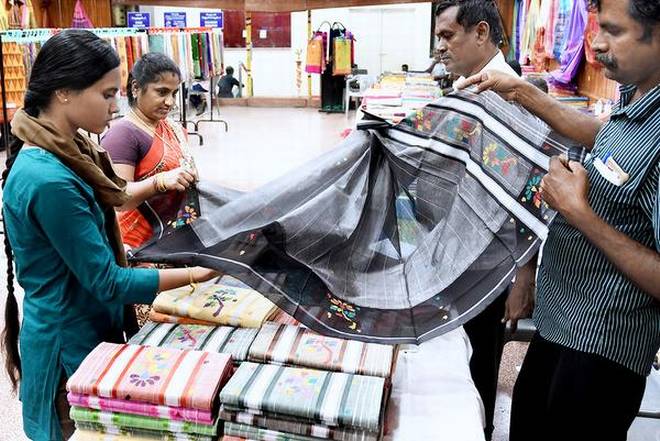
Handloom exhibition brings to light the traditional art of weaving
Did you know that in Tamil Nadu around 150 varieties of saris are woven? And that the State contributes to 12% of the country’s handloom production?
There is a lot more to handloom than just weaving. Creativity starts with choosing the yarn: ordinary coarse cotton to materials with lustrous finish, resembling silk. Choice of dyes involves thinking through: chemical dyes and vegetable dyes. Then there is the design — from Kancheepuram silk replicated on cotton to the famous Madurai sungudi apart from region-specific motifs.
Clusters of handloom weavers in small villages across Tamil Nadu have worked hard to create an exclusive collection of designs and weaves.
The Handloom and Textiles department has been training weavers to introduce new motifs not only to keep their looms going but also revive the art. One such effort is the chedibutti design.
Last of the generation
The design has become integral to a cluster of 200 families, mostly men over 50 years of age, in Veeravanallur of Tirunelveli district. They are the last of the generation to carry forward the traditional weaving of artificial silk.
“They are on old-age pension but we are keeping them employed by training them to weave new designs,” said R. Thamizharasi, joint director of the department. “As they are trained weavers all we are required to do is give them the design. Since they are conversant with the patterns they are able to incorporate it easily. We introduced the chedibutti design (a plant like motif with colourful flowers) three-four years ago and is now being woven by these families,” she added.
The State is ranked first in sari production and third in the country in handloom production. It has 3.19 lakh looms providing livelihood to 1.89 lakh families.
On Thursday, a week-long exhibition of cotton handloom saris was inaugurated by the department’s director C. Muniathanan at Sri Sankara Hall in Alwarpet. As many as 15 varieties of saris are on display.
source: http://www.thehindu.com / The Hindu / Home> News> Cities> Chennai / May 11th, 2018
06th
She fulfills her dream
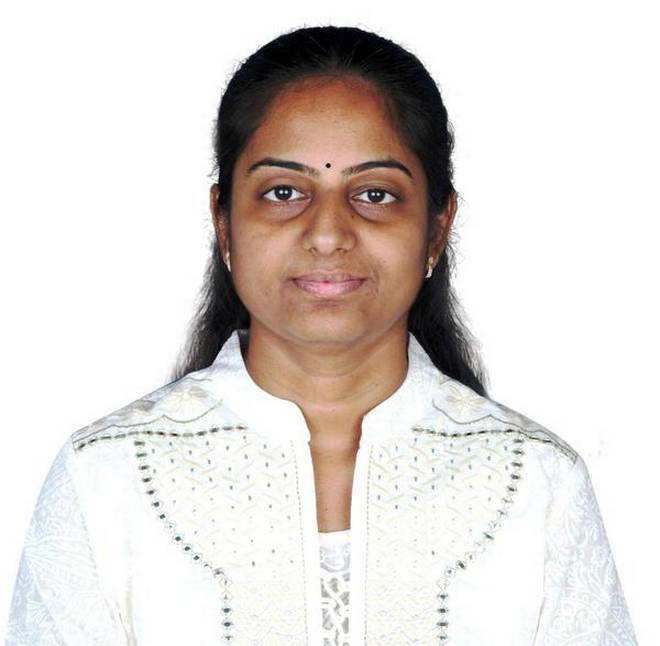
K. Nithya(34), a native of Devanampalayam village near Pongalur in Tirupur district, is jubilant as she had cleared the Civil Services examination this year with 223rd rank which offers hope of getting into her dream choice of Indian Administrative Service (IAS) under the OBC quota.
This is her fourth attempt at the examination. Earlier, she was allotted Indian Revenue Service (IRS) in her third attempt last year.
“It was my dream to get IAS because of the inspiration given by my father. I am almost sure of allotting IAS this year as the OBC candidates up to nearly 450th rank had got IAS in previous years,” said Mrs. Nithya who had given Indian Foreign Service, Indian Police Service, and Indian Revenue Service as the other options.
Her father used to work in a textile mill here, and later started a hotel. Hence, she studied at schools in Tirupur and Pongalur. She joined an engineering college in Coimbatore to pursue computer science.
Mrs Nithya joined Satyam Computers in Hyderabad where she met Raj Kishore, hailing from Andhra Pradesh, who became her husband. He lent all support to her to fulfil her dream of becoming an IAS officer.
“I will be happy to serve in any State. The IAS is the most charming among all other services. The duties of an IAS officer are more people-centric covering different social layers,” she told The Hindu.
source: http://www.thehindu.com / The Hindu / Home> News> Cities> Coimbatore / by Staff Reporter / Tirupur – May 01st, 2018
Saviour of indigenous seeds
Until a few years ago, he had been cultivating paddy and sugarcane alone, which are common in the region. However, there was nothing that made him excited neither in terms of yield nor in terms of revenue. This had made him switch over to vegetables, that too not the hybrid but the native crops, he says.”I switched to crops like brinjal, ladies finger, chillies, which have started to provide a good yield. Despite poor monsoon, I could get very good yield from vegetable cultivation when compared to paddy and sugarcane. Paddy and sugarcane require more quantum of water to cultivate. However, it is not the case of vegetables”, he opined.Though Saravanan is always eying on making a profit, he never compromised cultivating native vegetables. While other farmers are going for hybrid varieties aiming for good yield, he has been cultivating only country seeds.
“I have been cultivating brinjal, ladies finger, chillies and groundnut crops using country seeds, not a hybrid. Though I am only getting half of the yield when compared to a hybrid, I am able to earn revenue equal to what usually a hybrid variety would yield”, Saravanan stated.
If a farmer cultivates hybrid brinjal, say for an example, he could get a yield of 100 kg from an acre. While a country seed can able to get only 50 percent of the yield. However, Saravanan said that he could sell his produce for Rs 20 per kg when a hybrid produce could only fetch Rs 10 per kg, he added.
“Moreover, the cost of fertilizer, pesticides, maintenance cost will eventually come down to country seeds. However, it is not the case for a hybrid. It requires more fertilizer, pesticide and maintenance cost”, says Saravanan.
Saravanan is using cow dung, green manure and goat manure along with micronutrients like Azospirillum, Pseudomonas, and Phosphobacteria instead of using chemical fertilizers and pesticides. So, his large number of the customer base is purely because of the quality and taste of the produce, he said.
“I use the required scientific technologies such as seed nutrient management and water conservation methods in my field. I have established sprinklers to save water. Due to some practical problems, I am not using drip irrigation”, he added.
He said that whether it was a cash crop or food crop, a farmer’s ultimatum was profit. Apart from the yield, a farmer should be able to successfully market his produce.
He should not rely on wholesalers or agents. Only then can he/she could get a better price for his produce. So, the government should create more avenues to facilitate each and every farmer to sell their produce on their own, he further said.
source: http://www.timesofindia.indiatimes.com / The Times of India / News> City News> Trichy News / by D. Vincent Arockiaraj / TNN / May 03rd, 2018
02nd
Taking on British justice
I had meant to write this piece for my April 2nd column, but events overtook me, so it comes as a bit later reminder of new ownership taking over The Hindu on April 1, 1905. In selling it to the paper’s legal adviser, S Kasturiranga Iyengar, M Veeraraghavachariar, a founder who had become sole owner, made sure with a formal notice that this would not be considered an April Fools’ Day story.
But before that happened, Veeraraghavachariar made one last effort to keep control of the paper. On the advice of Kasturiranga Iyengar, a company with capital of ₹1,20,000 (1200 shares of ₹100 each) was formed with P Rungiah Naidu (Chairman), Dewan Bahadur R Ragoonath Row, P Anandacharlu, C Jambulinga Mudaliar, C Sankaran Nair, TV Seshagiri Iyer and M Tirumalachariar as Directors. Kasturiranga Iyengar was the Legal Adviser and Veeraraghavachariar the Manager. But by 1903 the scheme failed with less than half the shares subscribed. Two years later, on March 18, 1905, Kasturiranga Iyengar announced, “Mr. Sankaran Nair and myself have agreed to purchase The Hindu from Mr. Veeraraghavachariar for ₹75,000,” the latter selling it to them though he had received an offer for ₹5000 more. Sankaran Nair remained a co-owner till 1922.
Over the years, there were to be differences between The Hindu and Sir Sankaran, but the break came when they took opposing views on the question of Gandhiji and civil disobedience. Nair even wrote a book, Gandhi and Anarchy, in which he attacked Gandhiji and the Congress. The consequences of the book were unexpected. In it Nair wrote, “Before the reforms it was in the power of the Lieutenant-Governor (Sir Michael O’Dwyer of the Punjab), a single individual, to commit the atrocities in the Punjab we know too well.” This was with reference to the Jallianwala Bagh massacre that Sir Sankaran held was due to O’Dwyer giving the man-on-the-spot, Col. Reginald Dyer, an excessively free hand. O’Dwyer, angered by Nair’s charge, sued for libel in London, which is where Nair had once thought he would file charges against the Authorities for the massacre. Instead, as a member of the Secretary of State for India’s Council, he moved to England, and campaigned for a Royal Commission of Inquiry which led to several civil and military officials being punished for what happened in 1919. “As far as it lay in my power, I was determined to prevent another Jallianwala Bagh in India,” Nair stated of his success.
You win some, you lose some and the lawyer Sankaran Nair found himself paying for his views on Jallianwala Bagh and O’Dwyer. In London, the jury ruled against him after Justice McCardie kept intervening at every stage of the trial asking questions that favoured the plaintiff. O’Dwyer was awarded £500 damages and costs, which came to £7000.
The Hindu, which covered the trial extensively, called it “a hideous mockery,” adding, “almost from the first day when the trial commenced, it was apparent that Sir Sankaran Nair had lost the case.” The paper later wrote, “The case has only served to demonstrate once again that when there is the slightest touch of politics involved for an Indian, justice cannot be expected in an English Court and from an English jury. In such cases both judge and jury become weighted with the cares of empire. No wonder a case which was meant to test whether Sir Michael O’Dwyer was guilty of terrorism, resulted in the finding, altogether gratuitous, that O’Dwyer saved the empire, that justice was not done to Dyer… and that (the Inquiry had got it all wrong…)”
Ironically, the case led to Nair in 1924 wanting to sue The Hindu for libel alleging that it had accused him of “appealing to the Congress leaders in the matter of the suit (filed by Sir Michael O’Dwyer).” Matters were settled out of court.
Sir Sankaran Nair lived in The Palms on Poonamallee High Road and was, with Kasturiranga Iyengar, a member of the Egmore Group of lawyers, rivals of the Mylapore Group, which was mainly Brahmin.
Music maestro’s centenary
April 27th was the birth centenary of Handel Manuel, Madras’s ‘Mr. Western Classical Music’, (Miscellany, March 19) and it was a grand music event in the Manuel style at St Andrew’s Kirk, with which he was associated for over fifty years as organist and choirmaster.
Born in Tuticorin into an old Nagercoil family, he was named Handel by his music-loving father who thought George Frederic Handel’s Messiah was the greatest piece of Western Classical music ever written. His son lived up to his hopes. An untrained composer, he became an outstanding Classical musician after his time at Madras Christian College. But Handel Manuel was down-to-earth as well: He was Station Director Western Music, Madras.
A part of his legacy includes founding the Madras Philharmonic and Choral Society. And the Handel Manuel Chorus is a memorial to him founded by his younger brother and his wife, flautist Surender and Sarada Schaffter, in 2003. He was also instrumental in writing and augmenting the Western musical notes for the National Anthem. His son Vijay, considered by many the best pianist and bass player in India in his time, worked long with composer Ilayaraja for whom he played the keyboard. Handel Manuel was elected an Honorary Life Member of the Royal School of Church Music, London.
The chronicler of Madras that is Chennai tells stories of people, places, and events from the years gone by, and sometimes, from today.
source: http://www.thehindu.com / The Hindu / Home> Society> History & Culture / by S. Muthiah / April 30th, 2018
